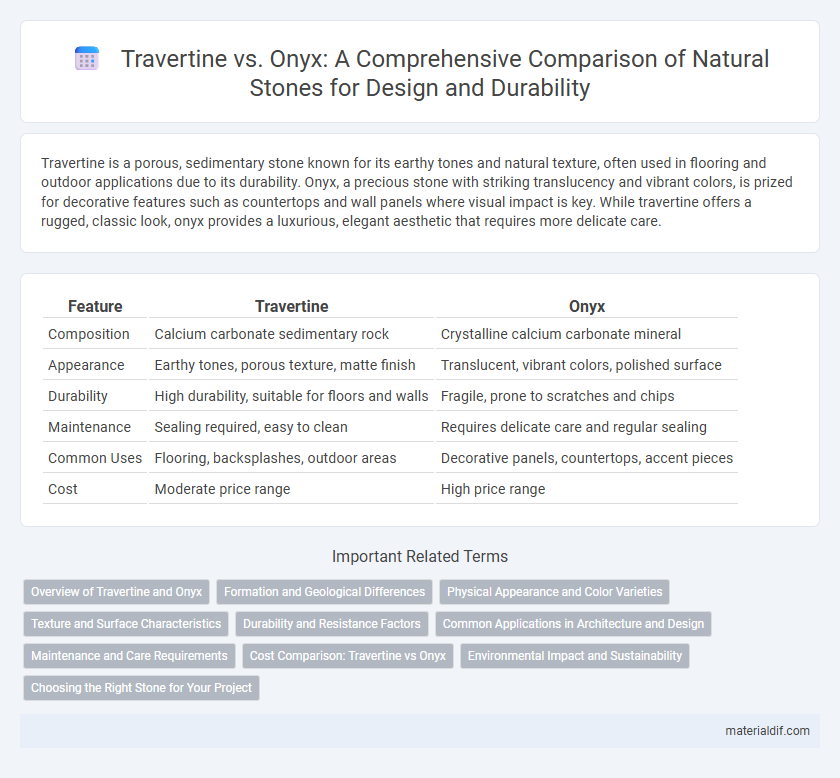Travertine is a porous, sedimentary stone known for its earthy tones and natural texture, often used in flooring and outdoor applications due to its durability. Onyx, a precious stone with striking translucency and vibrant colors, is prized for decorative features such as countertops and wall panels where visual impact is key. While travertine offers a rugged, classic look, onyx provides a luxurious, elegant aesthetic that requires more delicate care.
Table of Comparison
| Feature | Travertine | Onyx |
|---|---|---|
| Composition | Calcium carbonate sedimentary rock | Crystalline calcium carbonate mineral |
| Appearance | Earthy tones, porous texture, matte finish | Translucent, vibrant colors, polished surface |
| Durability | High durability, suitable for floors and walls | Fragile, prone to scratches and chips |
| Maintenance | Sealing required, easy to clean | Requires delicate care and regular sealing |
| Common Uses | Flooring, backsplashes, outdoor areas | Decorative panels, countertops, accent pieces |
| Cost | Moderate price range | High price range |
Overview of Travertine and Onyx
Travertine is a sedimentary limestone formed by mineral springs, characterized by its porous texture and warm earthy tones, making it popular in flooring and wall cladding. Onyx is a translucent banded stone composed primarily of calcite, prized for its unique patterns and ability to be backlit, commonly used in decorative applications and luxury interiors. Both stones offer distinct aesthetic appeal and durability, with travertine favoring rustic, natural settings and onyx providing an elegant, luminous look.
Formation and Geological Differences
Travertine forms through the rapid precipitation of calcium carbonate in mineral springs, primarily in limestone caves or hot spring areas, resulting in porous, banded layers. Onyx, a variety of chalcedony quartz, develops from the slow deposition of silica-rich solutions in volcanic caves, creating translucent, fine-grained banded patterns. The key geological difference lies in travertine's sedimentary carbonate origin versus onyx's silica-based, cryptocrystalline structure formed under different environmental conditions.
Physical Appearance and Color Varieties
Travertine displays a porous texture with natural pits and veins in earthy tones like beige, cream, and rust, emphasizing a rustic and warm appearance. Onyx showcases a translucent, smooth surface featuring dramatic banding and vibrant colors including white, honey, green, and deep red, offering a luxurious and striking visual impact. The distinct color varieties and textures make travertine ideal for traditional settings, while onyx suits contemporary designs demanding bold aesthetics.
Texture and Surface Characteristics
Travertine exhibits a porous, fibrous texture characterized by natural pits and troughs that often require filling to achieve a smooth surface, giving it a rustic and matte finish ideal for earthy designs. Onyx features a translucent, crystalline surface with smooth, polished textures that showcase vibrant veining and rich color contrasts, making it highly prized for decorative applications and backlit installations. The hardness of onyx is lower than travertine, resulting in a more delicate surface that demands careful maintenance compared to the durable and textured travertine.
Durability and Resistance Factors
Travertine, a form of limestone, offers moderate durability with natural pores that require sealing to enhance its resistance against stains and moisture. Onyx, a softer calcite-based stone, is less durable and more prone to scratches and etching, limiting its use to low-traffic, decorative applications. Both stones require careful maintenance, but travertine's higher compressive strength and abrasion resistance make it more suitable for flooring and exterior installations.
Common Applications in Architecture and Design
Travertine is widely used in flooring, wall cladding, and outdoor facades due to its durability and porous texture, making it ideal for both interior and exterior architectural applications. Onyx, prized for its translucency and unique veining, is often featured in decorative panels, countertops, and backlit installations to create striking visual effects in interior design. Both stones offer distinct aesthetic qualities, with travertine providing a rustic, natural look and onyx delivering luxury and elegance in high-end residential and commercial projects.
Maintenance and Care Requirements
Travertine requires regular sealing and gentle cleaning with pH-neutral products to prevent staining and surface erosion due to its porous nature. Onyx is more delicate and demands careful handling, avoiding harsh chemicals and abrasive tools to maintain its translucency and prevent etching. Both stones benefit from prompt spill cleanup and routine dusting to preserve their natural beauty and durability.
Cost Comparison: Travertine vs Onyx
Travertine generally costs between $15 and $30 per square foot, making it a more affordable option compared to Onyx, which ranges from $40 to $250 per square foot due to its rarity and translucency. The installation expenses for Onyx are also higher because of its fragility and the need for specialized handling, whereas Travertine's durability allows for lower labor costs. Considering budget constraints, Travertine suits larger projects, while Onyx is ideal for accent pieces or luxury applications where cost is less of a concern.
Environmental Impact and Sustainability
Travertine, a natural limestone, has a lower carbon footprint compared to onyx due to its abundant availability and less intensive extraction process. Onyx requires more energy-intensive quarrying and often involves the use of resin polymers for stabilization, impacting its overall sustainability. Choosing travertine supports eco-friendlier building practices by reducing energy consumption and minimizing waste in stone production.
Choosing the Right Stone for Your Project
Travertine offers durability and a natural, earthy appearance ideal for high-traffic areas and outdoor applications, while onyx provides a luxurious, translucent quality perfect for decorative accents and low-traffic interiors. Consider travertine for cost-effective, versatile flooring or wall cladding, whereas onyx suits statement pieces requiring careful maintenance due to its softer composition. Evaluate project requirements such as durability, aesthetic preferences, and budget to select the optimal stone for your design goals.
Travertine vs Onyx Infographic

 materialdif.com
materialdif.com